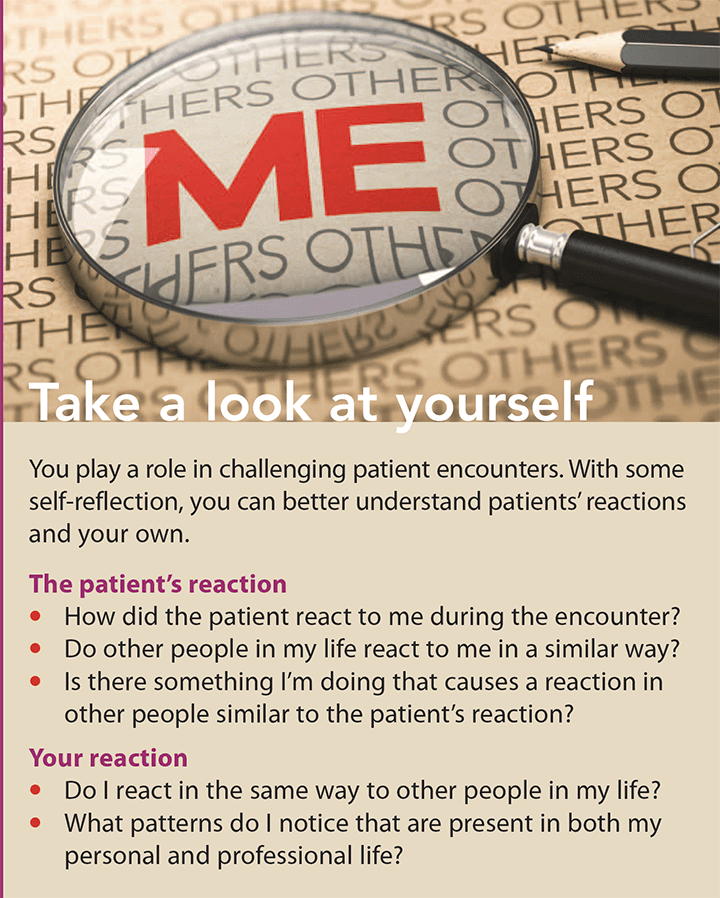What role do we play in mitigating or exacerbating difficult situations?
Takeaways:
- Challenging patient encounters threaten the quality of life of those involved and are likely to lead to responses that negatively impact patient care.
- As nurses, we can promote positive interactions by empathizing with patients, all of whom are managing more in life than their current symptoms or diagnosis.
- It’s crucial that we evaluate our own personal biases and stressors to avoid exacerbating challenging patient encounters further.
MS. SMITH arrives at the clinic without an appointment. She complains of flulike symptoms and states she needs to see a provider today. The schedule is busy and the clinic typically doesn’t take walk-ins, but Ms. Smith has been a patient for many years and is friends with the office manager. The staff do their best to work her in as quickly as possible. After 35 minutes in the waiting room, a patient room becomes available. Ms. Smith’s intake is completed and another 20 minutes pass. The provider is just finishing up with another patient when Ms. Smith, red in the face, opens the door and approaches the closest nurse. “What is wrong with you?” she snaps. “I’ve been waiting over an hour and I’m sick and this clinic is so far behind because of people like you who are lazy and slow!”
 Challenging patient encounters like this take a toll on everyone. Healthcare workers have reported increased rates of burnout and fatigue with continued exposure to challenging encounters. And patients who are concerned about being perceived as “difficult” by their providers are less likely to engage in shared decision-making, which conflicts with our principle of respect for patient autonomy and creates a power dynamic that’s potentially detrimental to the patient provider relationship. We must work to decrease the burden of these encounters to prevent negative patient outcomes and to protect our own mental health.
Challenging patient encounters like this take a toll on everyone. Healthcare workers have reported increased rates of burnout and fatigue with continued exposure to challenging encounters. And patients who are concerned about being perceived as “difficult” by their providers are less likely to engage in shared decision-making, which conflicts with our principle of respect for patient autonomy and creates a power dynamic that’s potentially detrimental to the patient provider relationship. We must work to decrease the burden of these encounters to prevent negative patient outcomes and to protect our own mental health.
In this article, we’ll identify the components of challenging patient encounters and discuss management tools to maximize clinical experiences and outcomes for both patients and ourselves.
Components of challenging encounters
What we call challenging is highly subjective, but what holds true for all of these encounters is that they threa ten the quality of life of those involved and are likely to lead to responses that negatively impact patient care. Challenging patient encounters boil down to three main components: the situation, the patient, and the provider.
The situation
A variety of factors can influence the situation of a patient encounter. For example, consider the patient’s literacy and language proficiency. Miscommunication can easily lead to frustration and a perceived power imbalance between the patient and healthcare provider. Also evaluate the physical environment. Multiple people in an exam room, a restless child, or a controlling spouse can adversely affect the patient encounter. And consider the nature of the encounter. A visit in which a worried patient is receiving bad news might understandably elicit different emotions than a routine visit.
The patient
Even a routine visit can turn into a challenge if the patient is expressing difficult-to-manage emotions or behaviors. Patients who are angry, defensive, frightened, manipulative, grieving, somatizing, or resistant can add to the complexity of a visit. These emotions and behaviors may be elicited by the clinical situation, such as in the case of a patient who’s frightened by his or her disease process or angry that insurance won’t cover a certain treatment. Alternatively, the behaviors may be part of the patient’s regular behavior and disposition, which may determine how your organization continues to care for this patient in the future.
The provider
Providers who are angry, defensive, fatigued, distressed, dogmatic, or arrogant may inadvertently cause or exacerbate a challenging interaction. Although certain situations and patient attitudes may be out of our control, we must do our best not to contribute to the situation. When we control our reactions, we may help diminish the severity of a challenging patient encounter or even avoid it altogether.
Management strategies
We can use several strategies to help us understand and mitigate our contribution to potentially challenging situations and decrease their frequency, which will result in better health for both patients and ourselves.
Model
Although we’ve all felt that hot flash of frustration or anger in response to a patient or situation, one of the best ways to prevent these emotions from interfering with our care is to consciously set the tone of the interaction. You can accomplish this by sitting still and speaking in a low, calm voice. In this way, we not only physically quiet ourselves, but also model the appropriate tone of the appointment for the patient. Also, make your expectations and boundaries clear, especially with a patient who’s showing signs of anger or inappropriate behavior or who has had a verbal outburst. Pay attention to the language you use—does it help create a collaborative environment? Using words like “we” and “us” can help foster mutual respect and responsibility as you and the patient decide on the best plan of action. (See Keep it collaborative.)

Empathize
Empathy requires not only emotional intelligence (the ability to identify and manage your own emotions and the emotions of others), but also a curiosity about what it must be like to be in the patient’s position. Remind yourself that patients may feel helpless or as if they’ve exhausted all plausible options. If a patient doesn’t receive empathy from you, he or she may not feel understood or taken seriously, which can lead to frustration and behaviors such as shouting or crying.
Identify
Many patients have never faced health challenges that may threaten their personal identity or even their mortality. We must learn how to recognize when a patient’s behavior is the result of ineffective coping. For example, Ms. Smith may be struggling with intense negative emotions at the prospect of an illness because she was recently diagnosed with diabetes and worries her body is failing her as she ages. When we recognize patients’ skill deficits, we can increase our empathy and more successfully navigate challenging encounters.
Strategize
Have a plan in place for strategically managing patients after a challenging encounter. The plan should include goals and a plan of care that takes into consideration individual patients’ cognitive levels, emotional abilities, and skill deficits. Reasonable goals that hold both parties accountable can help reduce future challenging situations. In Ms. Smith’s case, the clinic could commit to ensuring that her intake is complete and that she sees the provider within 30 minutes of her appointment time as long as Ms. Smith commits to calling before coming to the office.
Self-reflect
We must acknowledge the role we play in a challenging patient interaction. This is best achieved through self-reflection. (See Take a look at yourself.) For example, you might be excessively frustrated with Ms. Smith’s impatience because it reminds you of the frustration you felt the night before when your partner told you to hurry up and finish cooking dinner. Your irritated response to Ms. Smith is multiplied by the frustration you felt about your partner’s impatience. Identifying your triggers is a crucial step toward managing your reactions when these situations arise in the future.

After Ms. Smith returns to the patient room, the nurse calmly explains the situation to the provider: Ms. Smith had discovered a lump in her breast this morning. She’s quite concerned given her additional flulike symptoms. The provider refers Ms. Smith to a walk-in imaging clinic. When the nurse hands a tearful Ms. Smith the referral form, Ms. Smith apologizes for the outburst. The nurse thanks her for trusting their clinic with her care, and acknowledges the importance of taking steps to maintain her health.
Light the way
We’ve all had challenging patient encounters, many of which stemmed from factors outside of our control. However, we must evaluate these encounters to understand the role we play in either exacerbating or calming a situation, or even whether we were at the root of the challenging interaction.
When we take steps to set a calm and collaborative stage from the beginning of each patient interaction, extend empathy, identify skill deficits, construct strategic management plans, and continue ongoing self-reflection, we can walk with even the most challenging patients through their darkest moments. We may even give them the gift of some much-needed light.
The authors are at Vanderbilt University School of Nursing in Nashville, Tennessee. Kaitlyn Breiten, Eleanor Condie, Sarah Vaillancourt, and Jean Walker are graduate students in the women’s health nurse practitioner specialty. Ginny Moore is an associate professor of nursing and director of women’s health nurse practitioner specialty.
Selected references
Dudzinski DM, Alvarez C. Repairing “difficult” patient-clinician relationships. AMA J Ethics. 2017;19(4):364-8.
An PG, Manwell LB, Williams ES, et al. Does a higher frequency of difficult patient encounters lead to lower quality care? J Fam Pract. 2013;62(1):24-9.
Frosch DL, May SG, Rendle KA, Tietbohl C, Elwyn G. Authoritarian physicians and patients’ fear of being labeled ‘difficult’ among key obstacles to shared decision making. Health Aff. 2012;31(5):1030-8.
Hull SK, Broquet K. How to manage difficult patient encounters. Fam Pract Manag. 2007;14(6):30-4.
Schmidt HG, van Gog T, Schuit SC, et al. Do patients’ disruptive behaviours influence the accuracy of a doctor’s diagnosis? A randomised experiment. BMJ Qual Saf. 2017;26(1):19-23.
ant10-Challenging patients-926



















1 Comment.
As an RN I found this article to be incredibly helpful in the clinical setting. Nurses will face challenging patient situations regardless of their work environment (offices, hospitals, schools, etc.). I want to share an experience with you that provides evidence that many of the strategies mentioned in the article are truly beneficial.
I have been working as a labor and delivery nurse for nearly 3 years now. In recent years the trends for birth have become much like planning a wedding. Expectant mothers write out long birth plans and romanticize the act of bringing a child into the world. This new trend can sometimes make patient interactions difficult when things don’t go as the patient has so meticulously planned.
I want to tell you about an encounter I had with a mother who came in to be induced with her first child. From the get-go my patient let me know that she was not happy that she was having to be induced. Induction was never part of her plan, she had hoped to have a natural labor and birth with no interventions. Based on her body language I was able to tell that this mother was already getting agitated just by being the hospital. I sat down with my patient and spoke calmly with her about her fears and reservations with an induction and hospital birth. I was able to empathize with her and tell her she is not the only mother who has felt this way or who has experienced these feelings. We were able to strategize and make a plan for how she wanted her labor to go in spite of the need for various induction methods. Through this talk with her I gained her trust.
Throughout her labor I was able to be my patient’s advocate. I helped to explain in plain speak some of the medical interventions the doctors spoke to her about. When my patient and her husband got frustrated about continuing interventions I helped to calm their nerves by identifying with them. I always do my best to remind myself that what I see everyday at my job is often very scary for all my patients.
In the end I was able to have a very good relationship with my patient and her husband simply by applying the model mentioned in the article “Successfully Managing Challenging Patient Encounters”. I was able to empathize, identify, and strategize with this mother to make her birthing experience the best it could be, even though it did not go as she had planned. I remained calm and listened to their thoughts and concerns. I believe this model will be incredibly useful and helpful for nurses and providers alike. This model will help to enhance the patient experience and make them feel heard and valued. In the future I plan to continue to use the strategies I’ve learned to enhance my quality of care, therefore enhancing my patients’ experiences.
Sincerely,
Elizabeth Barker, ADN, RN